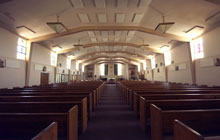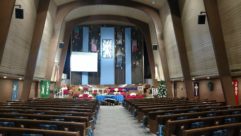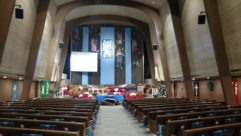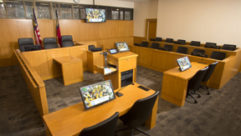

Modern Automixing
Oct 12, 2012 4:34 PM
The modest sanctuary of St. Anthony Claret Catholic Church in Anaheim, Calif., was at the height of architectural fashion when it was built in the late 1950s and has again come into vogue in the new century. However, its unintelligible sound reinforcement system was hardly state-of-the-art when installed decades ago. As the church’s musical ambitions and spoken-word requirements grew through the years, Reverend Rudolph Preciado contacted Newport Beach-based 7K Solutions to remedy the antiquated audio. Paul Dexter, owner of 7K Solutions, used an open-architecture Symetrix SymNet Solus 16 processor to create a system with 12 open inputs that could automix itself.
“The old sound reinforcement system was not performing well,” Dexter says. “An early-1980s rack of analog processing and amplification that had become ever-more ‘Frankensteined’ through the years drove a ceiling full of 8in., full-range loudspeakers.”
The church’s pipe organ is joined by a choir and, for some services, by a band that mixes itself on stage. Three microphones cover the choir, and Dexter replaced the band’s old mixer with an Allen & Heath MixWizard. Instead of a boundary mic at the altar, St. Anthony Claret now uses three wireless headset microphones for the priests, one wireless handheld microphone, and four optional podium microphones.
“The SymNet Solus 16 was the perfect solution at St. Anthony Claret
because I knew 16 inputs would be ample and eight outputs was all that were needed,” Dexter says. “The open-architecture programming would allow me to customize the system for the very particular needs of this church.”
In addition to some clever processing inside the SymNet Solus 16, Dexter corrected the intelligibility problem with a generous helping of acoustical treatment and a single, nearly-point source loudspeaker cluster. Dexter placed absorptive panels on the ceiling, sidewalls, and back wall. He placed several panels on the ceiling near the central loudspeaker cluster so as to minimize intelligibility-degrading early reflections. The loudspeakers are Fulcrum Acoustic DX1265s, powered by Powersoft amplifiers.
A single Symetrix ARC-2e wall panel remote provides all of the user control for the system. Dexter fixed the sanctuary’s output volume and then provided 10 steps of volume control for wireless microphones (as a group), the podium microphones (as a group), the choir microphones (as a group), and the band’s on-stage mixer. Additional menu pages provide output volume for the choir monitor (which contains all content except the choir mics) and the cry room. Behind the scenes, the SymNet Solus 16 provides additional zone control for the foyer and each main loudspeaker. Zoning out the loudspeaker cluster allowed Dexter to shade and tune each element to deliver even coverage from the front seat to the back wall.

PRODUCT AT WORK
Symetrix SymNet Solus 16
The Solus processor family is ideal for small to mid-sized installations not requiring I/O expansion. It is configured using open-architecture SymNet Designer software. System designers have the option to use or modify Solus DSP design templates for basic projects or to create unique designs entirely from scratch. There are three Solus hardware offerings: Solus 16 with 16 inputs and eight outputs, Solus 8 with eight mic/line inputs and eight outputs, and Solus 4 with four inputs and four outputs. Ethernet, ARC port, RS-232 port, two control inputs, and four logic outputs complete the control feature set. To simplify set-up, a front-panel LCD displays system settings. Solus supports Symetrix ARC wall panels, third-party control systems, and SymVue, a SymNet end-user control panel application.










